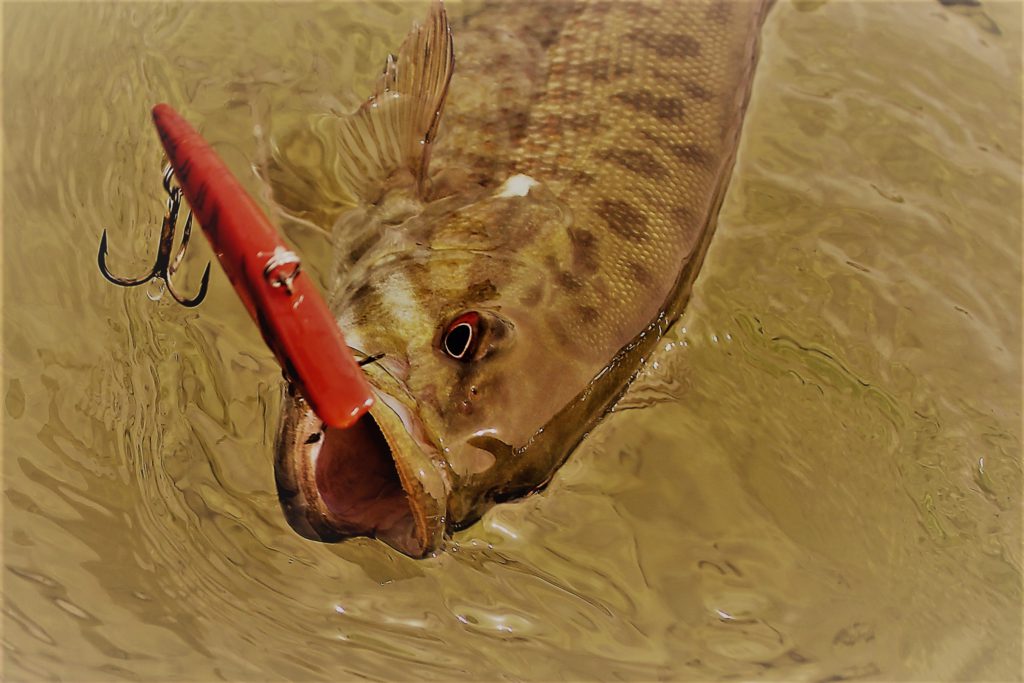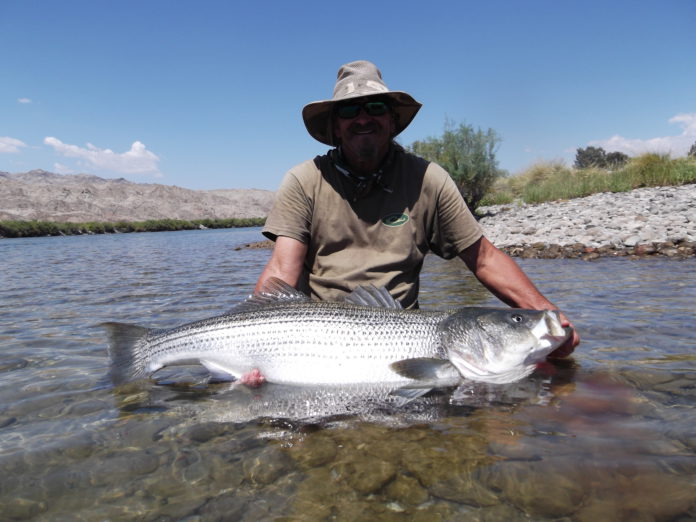The American Nile is a world-class fishery
BY GUNDY GUNDERSON
LAKE HAVASU CITY — Although under pressure from a burgeoning western population, the Colorado River system continues to provide a diverse, robust fishery that rivals any other in the West. Striped bass, largemouth bass, smallmouth bass, rainbow trout, redear, bluegill, crappie, channel and flathead catfish are the top gamefish in the system. Anglers can enjoy excellent catch rates in a sanguine wilderness setting. The terrific fishing melds with the timeless beauty of a desert landscape. Here is an overview of the many stretches of the river and the different angling species you might target.
Hoover Dam to Cottonwood Cove
This stretch of river produces more trophy striped bass than any other on the waterway. Clear, cold water flowing out of the Hoover Dam provides ideal trout habitat. The hatchery at Willow Beach and the state of Arizona stocks trout throughout the winter months. The nutrient-rich waters host a healthy aquatic ecosystem that grows trout quickly. The planted fish are derived from genetic river originals and thrive in the habitat. The healthy trout population creates plentiful feeding opportunities for big striped bass, which regularly grows fish in the 40- and even 50-pound class. These big fish are powerful enough to navigate the heavy river currents. There is a little shore fishing around Willow Beach but most angling takes place by boat.
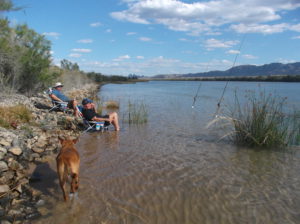
Prospects
A genuine blue-ribbon rainbow trout fishery with good fishing opportunities throughout the year, the consistently cold water flowing from the dam remains stable all year despite the hot summer air temperatures. The planter-size fish are plentiful too, especially in the winter months of stocking. There is also an excellent population of holdover rainbows ranging from 14 to 20 inches and another class of more rare giants ranging from 4 to 6 pounds. It is a big river system that grows trout.
Many trophy striped bass specialists target the big fish throughout the winter months coinciding with the trout plants. The stockers draw fish slightly above but mostly downriver from the hatchery to Cottonwood Cove. Naturally, you better your chances of hooking a big one at this time of year but these big fish are in the river system all year. The stretch above Willow Beach to the base of Hoover Dam is where some of the largest fish in the system have been caught, fish in the 50s and 60s. Dangerous flows, powerful eddies, hazardous rock bars and sandbars make it a stretch reserved for experienced boaters. Dam flows dictate conditions. For these reasons, the stretch is less pressured and holds more trophy-size striped bass.
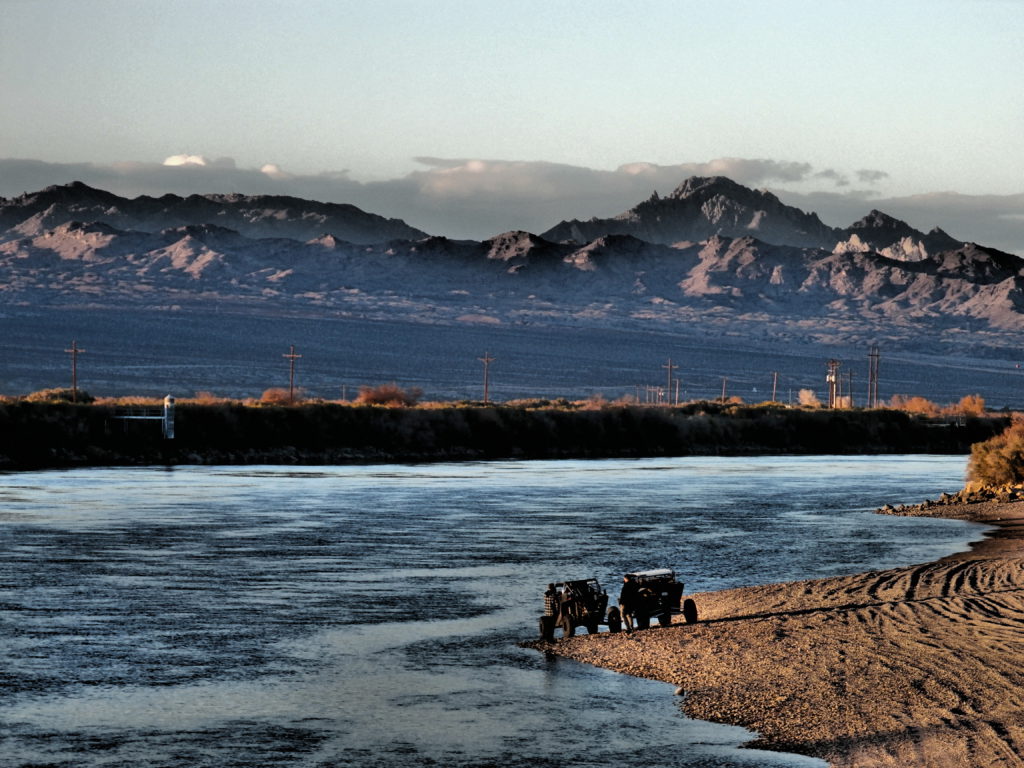
Lake Mohave
Beginning near Cottonwood Cove, the river transforms into a lake. It broadens out and the flow slows to a trickle. In the lake, there is a large population of threadfin shad and a growing population of gizzard shad. These fish provide a forage base for a diverse population of fish. There is an excellent striped bass population both trophy and school-size fish. The smallmouth fishery is terrific regularly producing catches up to 6 pounds. A smaller, northern-strain largemouth fishery occupies the back bays and still waters. There are also lots of channel cats and some redear.
Prospects
In the winter months, a best bet is to locate shad schools along the Davis Dam and spoon for striped bass and small and largemouth. The trout will also migrate down from the hatchery and can be caught both from boat and shore all along the lake. The shoreline around Katherine’s Landing is a favorite for shoreline trout fishers at this time of the year. Remarkably, the lake record rainbow trout went 16 pounds, 4 ounces.
As Havasu is an early bloomer in the spring, Mohave is generally a late bloomer. The bass don’t get active until late April, May and June. They will spawn in the backs of coves throughout the lake. After the spawn, the smallmouth can be found deeper off points where the drop-shot is a top tactic. A stealth presentation is requisite in the gin-clear water. Lipless cranks, crankbaits, tubes and Senkos are other top presentations. The lake has lots of steep rocky shoreline. Many smallmouth are taken off the continuation of these rocky bank outcroppings.
The largemouth are far fewer and prefer the still waters in the back bays and flats. In the dog days of a hot summer, small plastics fished on the drop-shot is a favored tactic. As the water begins to cool in the fall, a good topwater bite usually develops. As the winter approaches the shad schools return inviting the bass to gorge before winter.
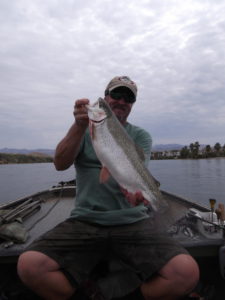
The lake has a healthy population of school-size striped bass ranging from 3 to 8 pounds with some smaller and many larger. In the winter months, school fish can be found near the dam, down deep on shad schools. Here they will eat a Hopkins Spoon. Other, more solitary fish can be taken along the shoreline with trout pattern swimbaits and glide baits. Larger fish will forage on the plentiful trout in shallow water. As the water warms in the spring, the striped bass can be found throughout the lake, when targeting points and drop-offs with swimbaits and hard jerkbaits is a top tactic. In the warm summer months, the fish spread out and finding them can be a hit or miss prospect. Bait fishing with cut anchovy is a good way to locate moving fish. Late in the fall, the shad reemerges and schools of stripers will be up, chasing the small baitfish. Shad pattern swimbaits, lipless crankbaits and pencil poppers are top lures at this time of the year. The bite shifts in the winter when the shad go deep.
Davis Dam to Lake Havasu
This is another good stretch for rainbow trout in the winter month. The nutrient-rich cold waters flowing from the dam are ideal for trout, holding fish most of the year. In the winter months the rainbows can be found as far south as Needles. But warmer river temperatures in the summer cause the fish to withdraw back to the dam tailings, where the water temperature usually hovers around 50 degrees all year. In the cooler months when the trout expand their range, larger striped bass can be found in proximity looking to forage on the bite-size fish. Arizona Game and Fish stocks the river at Davis Dam, Community Park and Rotary Park from November through February.
When the water warms in the spring, striped bass will move out of Lake Havasu and traverse upriver. The fish will forage aggressively on the northbound trek, eventually spawning under Davis Dam. Both shore and boat fisherman will encounter these traveling fish in good numbers. The first fish start moving in March, continue through April and are usually peaking in May — this is some of the best fishing of the year.
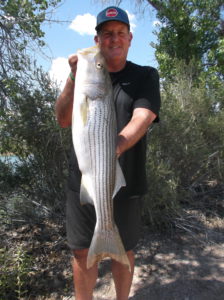
There is lots of backwater along this stretch, with the most being from the Topock Marsh south to the lake. Both smallies and largemouth will stage then nest in the shallows, providing some of the best catch numbers of the year. After the spawn, the bass will move back into the river or float back down to the lake.
This stretch also holds a world-class redear population with two IGFA record fish in the past several years. The backwaters from the I-40 Bridge to Blankenship Bend are prime areas in the spring. There is also a good channel cat population with the occasional flathead to boot. The Topock Marsh hosts a healthy bass population and a unique wintertime crappie fishery.
Prospects
In the winter months, Game and Fish plants regularly under Davis Dam. Anglers find good fishing for planters with a good number of holdover trout ranging from 14 to 18 inches. There are also some toads in here. A few years ago, I took a 7-pound, 6-ounce fish on an Agent Orange pattern X-Rap just south of the dam.
The plentiful trout draw in big foraging striped bass and some of the largest fish of the year are caught along this upper stretch. Trout pattern swimbaits, hardbaits and glide baits account for the bulk of the strikes. Pencil Poppers and AC Plugs are other favorites.
As the water warms in the spring, school-size striped bass will flood up the river system, out of the lake, providing some of the best fishing of the year. The fish are on the move so you may have to fish multiple spots to find them. River eddies are a top feature. Swimbaits, Bomber Long As and X-Raps are top choices. The first and last hour of the day, topwater baits like Pencil Poppers and big Chug Bugs can take a better fish. In the heat of summer, the best lure bites are early and late with cut anchovy working best in middle of the day. In the fall, as temperatures decline, the striped bass will retreat toward the lake and the topwater bite can be very good. Shad schools in the lake beginning late fall and early winter will draw most fish out of the river system. However, there’s always a chance of a stray big one anytime of the year.
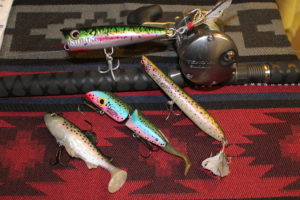
The bass fishing along this stretch can be very good, especially south of the I-40 Bridge. Expansive areas of backwaters provide miles of suitable bass habitat. Both smallmouth and largemouth can be found in healthy populations. The river will also hold big numbers of fish especially in the late summer and fall. Some of the fish will migrate up out of the lake, other fish are homeguard and travel from river to backwater. Senkos, tubes and flipping jigs are tops in the spring. As the fish return to the river, crankbaits, lipless cranks and drop-shot worms are summertime favorites. When the weather cools in the fall, for several weeks, the topwater bite is usually hot. Chatterbaits and spinnerbaits can also shine as shad starts to show in cooling water. Winter sees many of the bass — with the exception of Topock Marsh fish — retreat back toward the lake.
Lake Havasu
The bass fishing is king here but the lake also has some very good striped bass fishing too. The flats on the northern section of the lake and the backwaters upriver from the lake host a robust spawn in the spring, drawing both smallmouth and largemouth. The fish start moving as early as March. The Billy Williams Arm with the adjoining flats is another good area to find spawning and post-spawn fish. As the summer approaches, the bass, both largemouth and smallmouth spread out around the lake. The shoreline at Havasu is more typical lake habitat with tule beds, coves, points, flats, weed beds, back bays and artificial reefs. Late summer and fall, a good frog bite develops in the shallows and the topwater bite gets hot. By late fall, the threadfin shad emerge and the fish get on the bait.
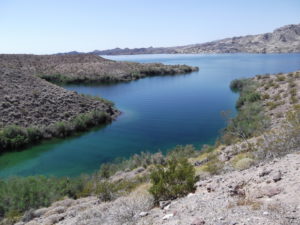
In the cooler water months, the shad schools emerge in the lake and the striped bass bites are closely associated with the small baitfish. A traditional winter hot spot is is the Havasu Springs area near Parker Dam and the early mornings are marked by working bird and surface activity. During the daytime, the fish go down. As the water warms the fish begin to move, with a part of the population moving up river to spawn and another part spawning in the lake — the fish are aggressive and will strike lures freely. The bait fisherman also put together good catches. As the heat of summer peaks, the fish scatter through the lake and river system toward the Davis Dam. When the shad schools emerge in the fall, the bulk of the striped bass are drawn back down to the lake. Redear channel, and large flatheads round out the catch. The Billy Williams area is a favorite for big flatheads.
Prospects
Most anglers choose to fish bass, as it is one of the best fisheries in the West. Target shallow fish in the spring with Senkos, flipping jigs and drop-shot worms. As the water warms, post-spawn, shallow cranks, squarebills and lipless cranks begin to shine. Summertime fishing sees fish in the shallows early in the day then moving off into deeper, cooler water. Drop-shot worms fished off drop-offs, points and the artificial reefs are effective. Late summer and fall, when amphibian populations peak, a good frog bite develops along the many miles of shoreline. Cooling temperatures and shorter days also kicks off a period of hot topwater fishing. Pop-Rs, Ricos and Zara Puppies are go-to baits as the fish get aggressive. Chatter baits are another late season favorite. When the shad begin to show in the late fall and early winter, the fish move off the shallows.
The striped bass fishing begins in late March when the fish start roaming and feeding in preparation for the spawn. Covering points, drop-offs and old river channel with search baits like swimbaits, Bomber Long As and Rat-L-Traps is a favored tactic. Topwater is effective early and late. The bait fisherman also do well by chumming, then bait fishing cut anchovy. Despite being a lake, there is a subtle north to south current that makes chumming effective at drawing in cruising fish. The fall is marked by an improved topwater bite and the first signs of shad schools draw the fish to the bait concentrations. Here again, swimbaits, lipless crankbaits, Long As and pencil poppers are top choices. In the winter months, anglers bait fish and lure fish among the bait schools.
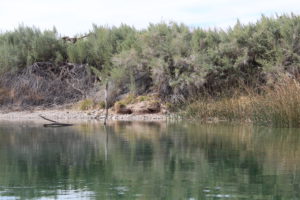
Parker Dam to Yuma
This stretch of river is about 140 miles long and hosts a variety of species including striped bass, smallmouth bass, largemouth bass, redear, crappie, channel and flathead catfish. It is the most overlooked section of the river. Miles of river and tons of backwater make for endless angling opportunities. With air temperatures often in the 70s in the wintertime, this is a year-round fishery. The flathead catfish is world class here, with the best fishing taking place but not limited to the summer months — big fish up to 80 pounds and are not uncommon. Several pothole lakes and larger bodies like Martinez, Senator Wash and Ferguson host big numbers of largemouth bass, bluegill and crappie. The smallmouth fishery is also robust with the scrappy fighters preferring the swifter moving waters of the main river channel. Panfisherman enjoy miles of good crappie and bluegill waters. There is much less boat traffic down here. If you are looking for more of the wilderness experience, this section, often referred to as the California Everglades, may be for you.
Prospects
This section of the river provides endless opportunities for the shallow-water largemouth bass angler. It is a pitching and flipping paradise with hundreds of miles of backwater and pothole lake shoreline. Sprawling marshes, sloughs and channels add to the appeal. Flipping and pitching jigs is a top tactic but Texas rigged worms, Senkos and shallow cranks are also effective. More moderate spring and fall conditions provide the year’s best fishing.
The smallmouth bass fishery also thrives despite warmer water habitat. The fish prefer the cooler waters and steady current of the main river channel. The aggressive feeding bass will take crawdad pattern shallow cranks and lipless cranks. Drop-shot 4-inch worms and shad pattern chatterbaits are other proven producers. As temperatures cool in the fall, a robust topwater bite develops. Pop-Rs, Ricos and Zara Puppies are local standbys.
With the excellent bass fishing along this stretch, the striped bass fishing is often overlooked. There are good numbers of mostly school-size fish ranging from 4 to 6 pounds with a few better kickers up to 15 pounds. Spring and early summer see some of the best fishing of the year as the fish migrate toward the many smaller dams along the waterway. The fish are stopped at the dam and tend to hang out nearby, feeding on plentiful schools of shad. Shad pattern swimbaits, lipless crankbaits and plastic Fluke-style baits are effective lures. Topwater baits like Zara Spooks, pencil poppers and Chug Bugs are also deadly especially early and late. The bait soakers also do well anchoring up, chumming, then fishing cut anchovy.
One of the most exciting fisheries and often unnoticed is the excellent fishing for trophy-size flathead catfish. Spring and summer are the best times of year but the big cats, which can range up to 90 pounds, can be caught all year long. Some of the best fishing takes place at night. It is a unique catfish fishery in that live bait is the preferred offering. Goldfish are legal here and can be a top bait. Shad is another standby, while small bluegill are another favorite. The live bait is fished in current with a heavy sliding sinker rig. Catching a 50- or 60-pound class catfish is not uncommon here.
